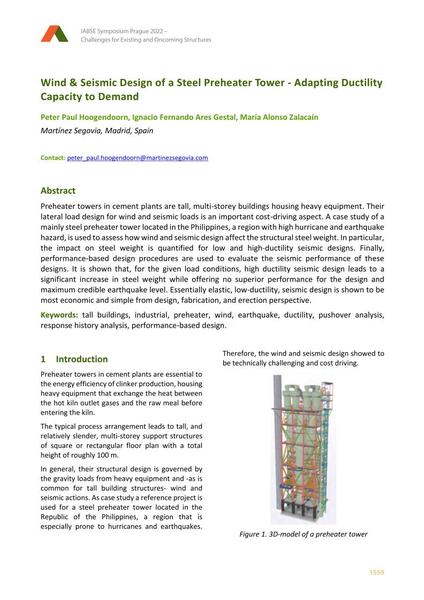Wind & Seismic Design of a Steel Preheater Tower - Adapting Ductility Capacity to Demand

|
|
|||||||||||
Détails bibliographiques
| Auteur(s): |
Peter Paul Hoogendoorn
(Martínez Segovia, Madrid, Spain)
Ignacio Fernando Ares Gestal (Martínez Segovia, Madrid, Spain) María Alonso Zalacaín (Martínez Segovia, Madrid, Spain) |
||||
|---|---|---|---|---|---|
| Médium: | papier de conférence | ||||
| Langue(s): | anglais | ||||
| Conférence: | IABSE Symposium: Challenges for Existing and Oncoming Structures, Prague, Czech Republic, 25-27 May 2022 | ||||
| Publié dans: | IABSE Symposium Prague 2022 | ||||
|
|||||
| Page(s): | 1559-1566 | ||||
| Nombre total de pages (du PDF): | 8 | ||||
| DOI: | 10.2749/prague.2022.1559 | ||||
| Abstrait: |
Preheater towers in cement plants are tall, multi-storey buildings housing heavy equipment. Their lateral load design for wind and seismic loads is an important cost-driving aspect. A case study of a mainly steel preheater tower located in the Philippines, a region with high hurricane and earthquake hazard, is used to assess how wind and seismic design affect the structural steel weight. In particular, the impact on steel weight is quantified for low and high-ductility seismic designs. Finally, performance-based design procedures are used to evaluate the seismic performance of these designs. It is shown that, for the given load conditions, high ductility seismic design leads to a significant increase in steel weight while offering no superior performance for the design and maximum credible earthquake level. Essentially elastic, low-ductility, seismic design is shown to be most economic and simple from design, fabrication, and erection perspective. |
||||
| Mots-clé: |
vent tremblement de terre
|
||||
| Copyright: | © 2022 International Association for Bridge and Structural Engineering (IABSE) | ||||
| License: | Cette oeuvre ne peut être utilisée sans la permission de l'auteur ou détenteur des droits. |
||||
